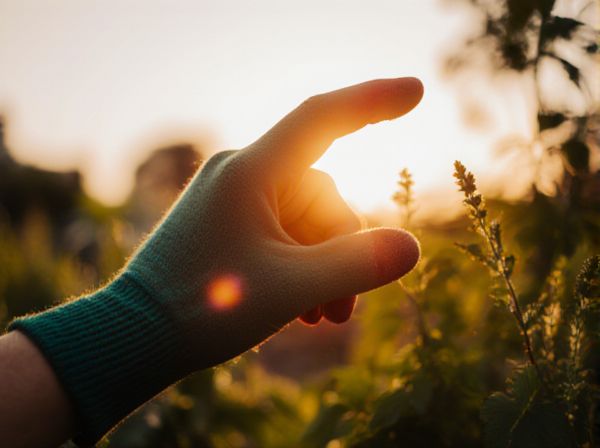
Sunburn vs Etiolation Illustration
Sunburn occurs when skin is overexposed to ultraviolet (UV) rays, causing redness, pain, and potential long-term damage. Etiolation happens in plants deprived of sufficient sunlight, leading to pale, elongated stems as they stretch toward a light source. Proper sunlight exposure prevents sunburn in humans and avoids etiolation in plants, promoting healthy skin and robust growth.
Table of Comparison
| Feature | Sunburn | Etiolation |
|---|---|---|
| Cause | Excessive exposure to direct sunlight | Insufficient light exposure |
| Appearance | Red, scorched leaves; browning tips | Pale, elongated stems; yellowish leaves |
| Plant Growth | Stunted or damaged growth | Excessive stem elongation, weak structure |
| Chlorophyll Production | Decreased, damaged chlorophyll | Reduced chlorophyll, lighter leaf color |
| Prevention | Provide shade during peak sunlight | Increase light exposure |
Understanding Sunburn and Etiolation in Gardening
Sunburn in plants results from excessive exposure to intense sunlight, causing leaf scorching, discoloration, and tissue damage that impairs photosynthesis and overall growth. Etiolation occurs when plants receive insufficient light, leading to elongated stems, pale leaves, and weak structure as they stretch toward light sources to maximize photosynthetic potential. Understanding these conditions helps gardeners balance sunlight exposure to promote healthy plant development and prevent stress-related damage.
Causes of Sunburn in Plants
Sunburn in plants is primarily caused by excessive exposure to intense sunlight, which leads to cellular damage and disrupted photosynthesis. High levels of ultraviolet (UV) radiation and elevated temperatures combine to break down chlorophyll and damage leaf tissues. This stress differs from etiolation, which results from insufficient light, causing elongated, pale growth.
What is Etiolation? Definition and Key Signs
Etiolation is a plant adaptation characterized by elongated stems, pale yellow leaves, and weak growth due to insufficient sunlight exposure. Unlike sunburn, which damages plant tissues from excessive sunlight and UV radiation, etiolation results from inadequate light triggering the plant's search for more light. Key signs of etiolation include stretched internodes, reduced chlorophyll production, and a general lack of robust, green foliage.
Symptoms: Sunburn vs Etiolation
Sunburn symptoms include red, painful skin with possible blistering and peeling due to excessive ultraviolet (UV) radiation exposure. Etiolation symptoms manifest as elongated, pale, and weak plant stems caused by insufficient sunlight, leading to chlorophyll deficiency. While sunburn reflects acute tissue damage from UV overexposure, etiolation indicates chronic light deprivation affecting plant growth and pigmentation.
How Sunlight Intensity Affects Plant Health
Sunlight intensity plays a crucial role in plant health by influencing both sunburn and etiolation. Excessive sunlight can cause sunburn, damaging leaf tissues with intense ultraviolet rays, leading to browning and reduced photosynthetic efficiency. Conversely, insufficient sunlight intensity triggers etiolation, characterized by elongated stems and pale leaves as plants stretch toward light, resulting in weakened growth and lower overall vitality.
Preventing Sunburn in Garden Plants
Preventing sunburn in garden plants requires providing partial shade during peak sunlight hours and applying protective mulch to regulate soil temperature. Selecting sun-tolerant plant varieties and gradually acclimating seedlings to increased sunlight reduces the risk of sunburn. Proper watering maintains plant health, enhancing resilience against damaging ultraviolet rays.
Avoiding Etiolation: Ensuring Adequate Light
Etiolation occurs when plants receive insufficient sunlight, causing pale, elongated stems and weak growth due to inadequate chlorophyll production. Avoiding etiolation requires providing plants with adequate light intensity and duration, typically 12 to 16 hours of bright, indirect sunlight daily. Ensuring optimal sunlight exposure promotes robust photosynthesis, vibrant foliage, and healthy plant development, preventing the detrimental effects of insufficient light.
Plant Species Most Vulnerable to Sunburn and Etiolation
Plant species most vulnerable to sunburn include tender-leaved varieties such as tomatoes, peppers, and cucumbers, which develop necrotic spots and tissue damage under intense sunlight. Etiolation predominantly affects shade-loving plants like ferns, violets, and certain orchids, characterized by elongated stems and pale leaves due to insufficient light. Understanding these species-specific responses helps optimize cultivation practices by balancing light exposure to prevent sunburn and etiolation.
Treatment and Recovery for Affected Plants
Sunburned plants require gradual shading and consistent watering to aid tissue repair, while applying anti-transpirants can reduce moisture loss. Etiolated plants benefit from increased light exposure and controlled fertilization to restore chlorophyll production and strengthen stems. Recovery times vary, with sunburn damage potentially leading to long-term tissue necrosis, whereas etiolation is often reversible with appropriate light management.
Best Gardening Practices for Optimal Sunlight Exposure
Sunburn causes leaf damage due to excessive sunlight, while etiolation results from insufficient light, leading to weak, elongated growth. Best gardening practices include providing plants with the right balance of sunlight--typically 6 to 8 hours of direct or filtered light depending on the species--and using shade cloths or positioning plants to avoid harsh midday sun. Monitoring sunlight exposure and adjusting placement according to plant-specific light requirements promotes healthy, robust growth and prevents stress-related issues.
Sunburn vs Etiolation Infographic

 gardendif.com
gardendif.com